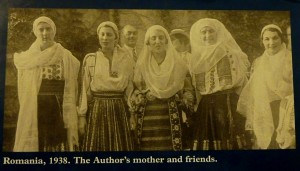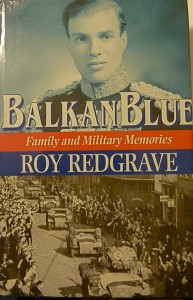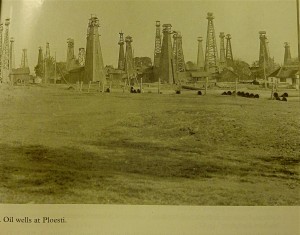Balkan Blue – Family and Military Memories
by General Sir Roy Redgrave
Book review:
The “Balkan” allude to the author’s maternal family
The Capsa family were of Vlach stock, from the Balkans – refugees from Moscopolis the Macedonian city which came under siege and was destroyed by the Ottomans in 1788. This caused the Capsa to seek shelter North of the Danube in Wallachia and they never looked back. They started from scratch and worked hard, improving their reputation as confectioners opening a cafe in the main avenue of Bucharest – the Calea Victoriei. This position became unassailable after Grigore Capsa went to school in Paris under the most famous confectioner Boissier. Grigore was so talented, that he became the only foreigner to be allowed to join Boissier at the Paris Exhibition. Here Capsa, presented Empress Eugenie, the spouse of Napoleon III, some of his confiseries and his reputation was made. Although he was offered to become the purveyor of the French Imperial Household Capsa returned to his family business in Bucharest. Within two generations of settling in Romania the Capsa, were appointed purveyors to the Royal family and with it they were patronised by aristocratic and professional classes.
The Capsa Cafe is Bucharest was modeled after Cafe de Flore in Paris and like its Parisian counterpart it became the meeting place for the intellectual elite of the country until WWII. This was a magnet for writers, actors and poets who made their reputation here at what used to be nicknamed the "Academy"
This was the time of the Belle Epoque when Bucharest was visited by trainloads of tourists from Western Europe coming on the Orient Express on the way to Istanbul, The capital of Romania became known as "Le Petit Paris". The french writer and diplomat Paul Morand used to come by private plane just to buy caviar and confectionery from Capsa, which by now was exported to Vienna Berlin and Paris. The whole atmosphere of joie de vivre was captured in the books of Gregor von Rezzori, Paul Morand, Marie of Edinburgh, Satcheverell Sitwell, Patrick Leigh-Fermor or Olivia Manning. This was a world which was soon going to be destroyed once the Soviet armies occupied the country to impose a communist dictatorship.
Sir Roy’s description of his family roots and childhood in pre-war Romania is epic and full of fun: he brings back to life a world which had disappeared a good six decades ago, under the sledgehammer of the Soviet occupation and their imported ideology.

the Author's Mother Mrs Micheline CAPSA in Romanian dress (centre) with her friends at her country house in the Carpathian Mountains, at Doftana
In this period picture you have a glimpse at the ‘civilised face of Romania’, which was soon going to disappear, either in exile or, for those who were left behind, to end up in the Communist Gulag; this marked the demise of the Capsa family in Romania, which coincided with the destruction of the Romanian elite.
Mrs. Micheline Capsa Redgrave, seen here in the centre of the photo was lucky enough to escape the Communist quagmire, as her English husband enabled the family to resettle in Britain. Here her son Roy Redgrave had a brilliant career in the Army, but all the Romanian properties in the Carpathians and in Bucharest were confiscated and destroyed. Roy Redgrave’s father was involved in Romania’s oil industry in the famous Ploiesti fields, not far from Doftana, where the Capsa had their estate: Micheline Capsa, the author;s mother was herself the daughter of general Capsa who distinguished himself in Romania’s war of Independence and was responsible on behalf of the Romanian Royal family for the ceremonies given during the visit of Czar Nicholas II and his family to Constanta before WWI.
In the 21st century the Capsa Hotel and Cafe were restored by their new owners but its patrons and atmosphere changed for ever: the new money grates!
The “Blue” alluded to in the title “Balkan Blue” refers to Sir Roy’s military Careers with the “Royal Blues”:indeed, Sir Roy was a Commanding Officer of the Household Cavalry Regiment in 1962 and of the Royal Horse Guards in 1964. Sir Roy Redgrave’s career made its mark during World War II on the Western front and after as Commander of the British Forces in Berlin, in 1975 and in Hong Kong (1978-1980).
He married Valerie Wellesley, a descendant of the Duke of Wellington through a long array of distinguished military figures.
The “Redgrave“ have, of course, through Sir Roy’s first cousins, a long association with the Theatre, Television and Politics. In this latter context it may not be entirely fortuitous that the actress Vanessa Redgrave got involved in the conservation of the natural and ethnographic habitat of the Transylvanian Alps, whose environment is under severe threat from the mining Industry.
This is a great read and a learning curve about life in two very different worlds – yet, regardless of such bipolar family traditions, or should it be precisely because of them, the author’s military duties make the whole world become his oyster: a task which Sir Roy performs with greatest ease, which turns the book into a most enjoyable read.




No Comments so far ↓
There are no comments yet...Kick things off by filling out the form below.